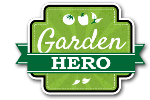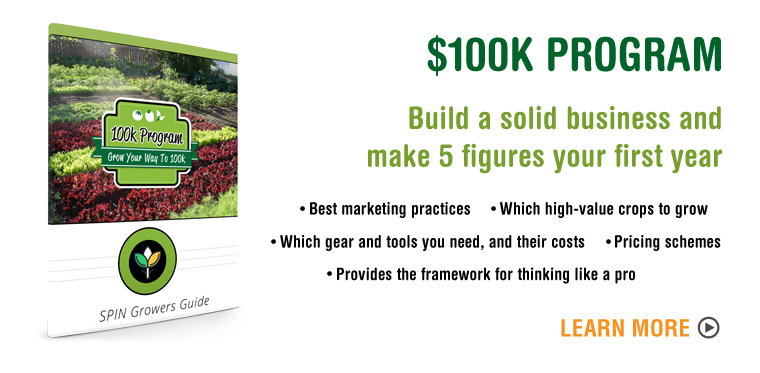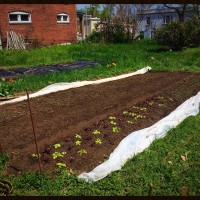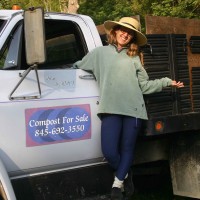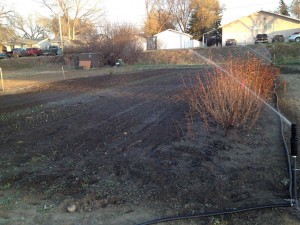
Caroline Barrington is owner/operator of Clean Spade Farm, which uses garden size plots to generate farm-size income.
Caroline Barrington’s town is not the most progressive, but her enthusiasm for health was contagious. In Swift Current SK she became known as the go-to-person for local food, and when she started turning her garden into a business using the SPIN-Farming growing plan and business model, her rainbow carrots and golden beets put her on the map.
Here, she tells how she built her business with veggies no one had seen before.
GROWING SPACE
How did you turn your garden into a business?
I started out in 2014 with my “Creek Garden” which is about 6300 sq ft. I rent this from the City for $78/year which is cheap but I have to irrigate from the creek. This is located adjacent to back alley that is behind the houses across the street from my house. Subtracting some berry bushes that are there, I end up with equivalent of about 64 – 24″ x 25′ beds. This in addition to 7- 8’x 4′ raised beds + another small space (3 x half size beds) in my own backyard.
In 2015 added the “Farm Garden”. M boyfriend has a certified organic grain farm 42km north of town (at Stewart Valley) so I took 5000+ sq ft of a field. I am unsure of the exact definition of peri-urban but I would call this rural. I made this into 30 – 50′ beds so basically doubled my space. Purchased a drip irrigation system and watered from the dugout.
We hear you are expanding this year?
I will keep the “Creek Garden” since it is closer to home and I have a bunch of garlic planted there!, but not the “Farm Garden”. It is too far away and has huge weed issues. But this year my boyfriend has the opportunity to purchase “Ginter Garden”. I plan to rent it for the taxes. Williard Ginter grew potatoes there for about 20 years but he passed away and his widow and daughter don’t want it. It is located one block east of my “Creek Garden”. According to drawings it is .48 acres. It is pie-shaped and a good amount is taken up by large trees so I haven’t figured out exact area or how many beds. It is approx. 11, 250 sq feet of usable garden (yikes!). I am a little unsure of taking this on when I know I can do more with what I have now.
PRODUCTS
What veggies do you grow?
Here’s my list from 2015:
Onions – scallion which some became large white, yellow, red + a few experimental organic cipolini red & yellow from seed
Garlic – leftovers from crop failure 2014 (bonus!) + some planted fall 2014
Radishes
Romaine lettuce
Mesclun mix lettuce
Spinach
Kale (black and winterbor)
Rainbow chard
Beets (regular and golden)
Carrots (rainbow, purple haze, mokum, and another variety can’t think of now short and round)
Snap peas
Potatoes (5 types)
Squash (3 types) (mostly fail!)
tomatoes (6 types)
Parsnips
Zucchini
Cabbage
Brussels sprouts (fail!)
Pea shoots
Sunflower shoots
radish, broccoli, purple cabbage, arugula and broccoli-brassica mix microgreens
Small amounts of:
Celery
Dill
English cucumber
Oregano
Rosemary
Thyme
Wheatgrass
What strategy did you use to decide what to grow, and how much was it influenced by the health benefits of a particular crop?
I would say my primary strategy here was to grow things that were not like all the other veggies at the market. Most of my competition here comes from Hutterite colonies and they all grow the exact same things, and sell them relatively cheap. I don’t want to compete with that. But now they copy me and actually sell beets with the greens on!
Lots of greens in both years because as a health coach, I am always telling people they need to eat greens every single day, and to mix up the types. I can’t help getting excited about them, and it seems to sell them at the market! Of course I like the $ potential of the shoots/microgreens and it was fun to be the only one selling those at market. Beets with greens were great “it’s like two veggies for the price of one!” Also love the weird veggies like golden beets and purple carrots. I can’t count the number of people who came over to my table and asked about them, especially golden beets!
Decided to do CSA boxes in 2015 (12 x 16 weeks) so added variety to make sure the boxes weren’t the same every week. I used the farm garden for the long growing veggies – potatoes, onions, carrots, squash but grew the rest in town.
It looks like you also sell juice. Is this a value added product that you use your veggies in?
I did sell juice once in 2014 on a market day that I didn’t have as much veggies to sell. It was a lot of prep in the morning. Also did smoothies once or twice that year (made on site). But I would have had to get a special permit to do it in 2015 and I didn’t bother (busy enough even though people sure asked for them!). I will explain that before I started growing veggies for market (2012 and 2013) I sold green smoothies as well as promoted myself as a health coach at the farmers market.
You also sell products you do not produce. What are they and how does the financial arrangement work? Do you buy the products wholesale? Can you return unsold goods?
I sell other local, mostly organic, unique foods as well. I have fresh farm/free run/pasture raised “happy chicken” eggs year round. I buy them from local producers (now have 4) and resell them. My profit is $1-1.50/dozen. People can’t get enough of these at the market because no one else offers any! I started doing this to help out a friend from home a couple years ago and it just caught on – I don’t really promote it. Keeps me in free eggs!
Also I offer local certified organic beef, grass fed lamb, kimchi, sauerkraut, sour cherry juice, grains, honey (from home only). You could say I have a passion for local chemical-free/organic foods and their producers!
This year I started a partnership with two other growers and sold some of their produce at market and used some in CSA boxes to give more variety. I racked my brain for a long time to come up with an agreement that I could use that respected their hard work and also mine. Here’s how that worked:
–They brought what they had available on Thursday or Friday to my house (not items I already had lots of-just complementary veggies or the things I thought would sell the best). Washed but not perfect. I weighed it in.
–I washed everything perfectly and bagged/bunched it and noted how many units were created.
–I would use some in CSA boxes Friday afternoon and the rest went to market.
–Whatever didn’t sell, they were welcome to come pick up after market if they wanted.
–Whatever did sell, they were paid 60% of what I made (based on 2/$5 unit price)
–I made up an itemized breakdown that they signed and we each got a copy for our records.
 Caroline is so successful selling that other local growers and food producers want her to sell their wares, too.
Caroline is so successful selling that other local growers and food producers want her to sell their wares, too.
I have producers coming out of the woodwork looking for me to sell their stuff! I think I will but really only for the CSA. I want to quit growing potatoes for instance! Too much work and too darn heavy! But fingerling potatoes I think I might do 🙂 I think I could sell a 50 box CSA easily but I sure can’t grow all that.
MARKETING – 2015
You sold at a farmers market. Did you do a single market each week, or multiple markets?
Saturdays, 10am-3pm were it. It runs 16 weeks from mid-June to end of September.
How well did you do at the farmer’s market?
Good! It is busy as it is only a part of “Market Square” that the City promotes. Lots of traffic.
You also offered seasonal CSA’s. How many of those did you sell?
12 CSA boxes for the same 16 weeks as market. 5 Large (12 items for $40), 7 Small (7 items for $250) I bartered a share to the delivery driver.
You write a blog, have websites and a facebook page. Do you do any other type of marketing?
Word of mouth – people seem to know me as the local food person and people will refer me customers. I created a small community garden at the local food bank and I do donations there sometimes that has my labels on it. I do random free talks for groups on off season. Also I started and coordinate a local networking group “Southwest Sask Organics” and we have events for consumers and producers. All these things increase my visibility. I work with another local lady who sells “good food boxes” so my labelled products go into her boxes sometimes.
In addition to farming, you are a health coach. What does a health coach do?
Great question! Health coaches can really vary, but I mostly work with folks who suffer from digestive issues, individually or in groups. The issues are addressed in a holistic manner. I always start with food but also talk about how to deal with stress and how other lifestyle factors. Unfortunately health coaching requires a LOT of computer time which I realized I hated and didn’t want my kids copying that computer time…therefore decided to focus mostly on market gardening.
How do you incorporate your knowledge of nutrition and the health services you provide with your farm business?
At this point I have mostly just added value by giving people lots of cooking/health tips when they buy veggies! But I may do a group detox and offer a food box to go with it that would be used in the recipes. I used to do a health newsletter but haven’t in over a year. I think it could be great way to combine these is to have a CSA newsletter that would say what is in the box that week, but the health benefits of it and a health recipe too. Just didn’t get to it last year…sleep was in short supply!
Do you do all the farm work alone?
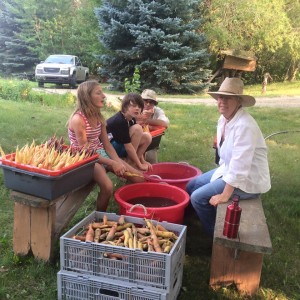
Backyard farming can be a family affair. Caroline Barrington grows with her son and daughter, teaching them responsibility and basic business skills, in addition to gardening.
No but a lot of it!
I pay my kids and other neighbourhood kids $5/hour to harvest/wash/package veggies with me. I also had one official employee this year (min wage + ugly/extra veggies) and some other random adults casually helping out for the same min. wage + veggies. Luckily for 6 weeks I hosted a WWOOFer who worked roughly 5 hours a day in return for room & board (we ate well!). My boyfriend helps out here and there but mostly with packaging on Thursday and Fridays. I do his farm books for free in return (and cook! haha) .
Your 2 children also work on the farm?
They are 10 and almost 12 now. I make them work 1 hour/day (or more) for the farm. I pay them cash after each market and make them give me back half for their bank account 🙂
Did you start out full-time or part-time?
2014 would be considered part time but it was pretty busy! 2015 I would say full time. I haven’t been good at tracking my time as I’m always wedging kid stuff in between work as a single mom they are still my #1 priority!
What is your 2016 revenue target?
$25,000 (and less expenses)
What will you be adding or deleting from your crop repertoire and product line?
Delete regular potatoes, brussel sprouts and probably cabbage.
Add new greens and want to offer salad mixes. I want this to be my focus.
Mostly need to grow either more or less of things, and more staggered plantings.
Will you use the same sales channels in 2016 or new ones?
I anticipate farmers market to be about the same. I want to increase CSA to 50 with a lot of outsourcing of things I don’t want to grow.
I am also planning to increase restaurant sales substantially.
Any parting thoughts?
I can tell you, unless you have a whole lot of discretionary income, changing over your way of eating and shopping doesn’t usually happen overnight. It took me years! But making small changes, continuing to seek out ways to eat clean on our budget, and finding ways to funnel more money over to the food line is an investment…and it is one that needs to be made.
Find out more about the growing plan and business model Caroline Barrington uses here. If you’re not ready to go all-in just yet, get a taste of what starting a backyard-scale farming business is like from our members with a month-to-month membership here.
